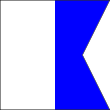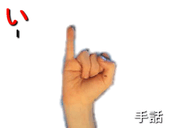I (kana)
い in hiragana or イ in katakana (romanised as i) is one of the Japanese kana each of which represents one mora. い is based on the sōsho style of the kanji character 以, and イ is from the radical (left part) of the kanji character 伊. In the modern Japanese system of sound order, it occupies the second position of the syllable chart, between あ and う. Additionally, it is the first letter in Iroha, before ろ. Both represent the sound [i]. In the Ainu language, katakana イ is written as y in their Latin-based syllable chart, and a small ィ after another katakana represents a diphthong.
| Form | Rōmaji | Hiragana | Katakana |
|---|---|---|---|
| Normal a/i/u/e/o (あ行 a-gyō) |
i | い | イ |
| ii ī |
いい いー |
イイ イー |
| Other additional forms | ||||||||||||||||||
|---|---|---|---|---|---|---|---|---|---|---|---|---|---|---|---|---|---|---|
|
| i | ||||
|---|---|---|---|---|
| ||||
| transliteration | i | |||
| hiragana origin | 以 | |||
| katakana origin | 伊 | |||
| spelling kana | いろはのイ (Iroha no "i") | |||
| kana gojūon | ||||||||||||||||||||||||||||||||||||||||||||||||||
|---|---|---|---|---|---|---|---|---|---|---|---|---|---|---|---|---|---|---|---|---|---|---|---|---|---|---|---|---|---|---|---|---|---|---|---|---|---|---|---|---|---|---|---|---|---|---|---|---|---|---|
|
||||||||||||||||||||||||||||||||||||||||||||||||||
Variant forms
Like other vowels, scaled-down versions of the kana (ぃ, ィ) are used to express sounds foreign to the Japanese language, such as フィ (fi). In some Okinawan writing systems, a small ぃ is also combined with the kana く (ku) and ふ to form the digraphs くぃ kwi and ふぃ hwi respectively, although the Ryukyu University system uses the kana ゐ/ヰ instead. In hentaigana, a variant of い is appeared that written as cursive Kanji 以.
Origin
い comes from the left part of the Kanji 以, while イ originates from the left part of the Kanji 伊.[1]
Stroke order
 Stroke order in writing い |
 Stroke order in writing イ |

The Hiragana い is made in two strokes:
- At the top left, a curved vertical stroke, ending with a hook at the bottom.
- At the top right, a shorter stroke, slightly curving in the opposite direction.

The Katakana イ is made in two strokes:
- At the top, a curved diagonal line going from right to left.
- In the center of the last stroke, a vertical line going down.
Other communicative representations
| Japanese radiotelephony alphabet | Wabun code |
| いろはのイ Iroha no "I" |
 |
|
 |
 |
| Japanese Navy Signal Flag | Japanese semaphore | Japanese manual syllabary (fingerspelling) | Braille dots-12 Japanese Braille |
- Full Braille representation
| い / イ in Japanese Braille | ||
|---|---|---|
| い / イ i | いい / イー ī | +い / +ー chōon* |
* When lengthening "-i" or "-e" syllables in Japanese braille, a chōon is always used, as is standard in katakana orthography, instead of adding the い / イ kana.
| Preview | い | イ | イ | ㋑ | ||||
|---|---|---|---|---|---|---|---|---|
| Unicode name | HIRAGANA LETTER I | KATAKANA LETTER I | HALFWIDTH KATAKANA LETTER I | CIRCLED KATAKANA I | ||||
| Encodings | decimal | hex | decimal | hex | decimal | hex | decimal | hex |
| Unicode | 12356 | U+3044 | 12452 | U+30A4 | 65394 | U+FF72 | 13009 | U+32D1 |
| UTF-8 | 227 129 132 | E3 81 84 | 227 130 164 | E3 82 A4 | 239 189 178 | EF BD B2 | 227 139 145 | E3 8B 91 |
| Numeric character reference | い | い | イ | イ | イ | イ | ㋑ | ㋑ |
| Shift JIS[2] | 130 162 | 82 A2 | 131 67 | 83 43 | 178 | B2 | ||
| EUC-JP[3] | 164 164 | A4 A4 | 165 164 | A5 A4 | 142 178 | 8E B2 | ||
| GB 18030[4] | 164 164 | A4 A4 | 165 164 | A5 A4 | 132 49 151 52 | 84 31 97 34 | 129 57 209 55 | 81 39 D1 37 |
| EUC-KR[5] / UHC[6] | 170 164 | AA A4 | 171 164 | AB A4 | ||||
| Big5 (non-ETEN kana)[7] | 198 168 | C6 A8 | 198 251 | C6 FB | ||||
| Big5 (ETEN / HKSCS)[8] | 198 234 | C6 EA | 199 126 | C7 7E | ||||
| Preview | ぃ | ィ | ィ | |||
|---|---|---|---|---|---|---|
| Unicode name | HIRAGANA LETTER SMALL I | KATAKANA LETTER SMALL I | HALFWIDTH KATAKANA LETTER SMALL I | |||
| Encodings | decimal | hex | decimal | hex | decimal | hex |
| Unicode | 12355 | U+3043 | 12451 | U+30A3 | 65384 | U+FF68 |
| UTF-8 | 227 129 131 | E3 81 83 | 227 130 163 | E3 82 A3 | 239 189 168 | EF BD A8 |
| Numeric character reference | ぃ | ぃ | ィ | ィ | ィ | ィ |
| Shift JIS[2] | 130 161 | 82 A1 | 131 66 | 83 42 | 168 | A8 |
| EUC-JP[3] | 164 163 | A4 A3 | 165 163 | A5 A3 | 142 168 | 8E A8 |
| GB 18030[4] | 164 163 | A4 A3 | 165 163 | A5 A3 | 132 49 150 52 | 84 31 96 34 |
| EUC-KR[5] / UHC[6] | 170 163 | AA A3 | 171 163 | AB A3 | ||
| Big5 (non-ETEN kana)[7] | 198 167 | C6 A7 | 198 250 | C6 FA | ||
| Big5 (ETEN / HKSCS)[8] | 198 233 | C6 E9 | 199 125 | C7 7D | ||
Footnotes
| Look up い, ぃ, イ, or ィ in Wiktionary, the free dictionary. |
- Where do the kana come from
- Unicode Consortium (2015-12-02) [1994-03-08]. "Shift-JIS to Unicode".
- Unicode Consortium; IBM. "EUC-JP-2007". International Components for Unicode.
- Standardization Administration of China (SAC) (2005-11-18). GB 18030-2005: Information Technology—Chinese coded character set.
- Unicode Consortium; IBM. "IBM-970". International Components for Unicode.
- Steele, Shawn (2000). "cp949 to Unicode table". Microsoft / Unicode Consortium.
- Unicode Consortium (2015-12-02) [1994-02-11]. "BIG5 to Unicode table (complete)".
- van Kesteren, Anne. "big5". Encoding Standard. WHATWG.

